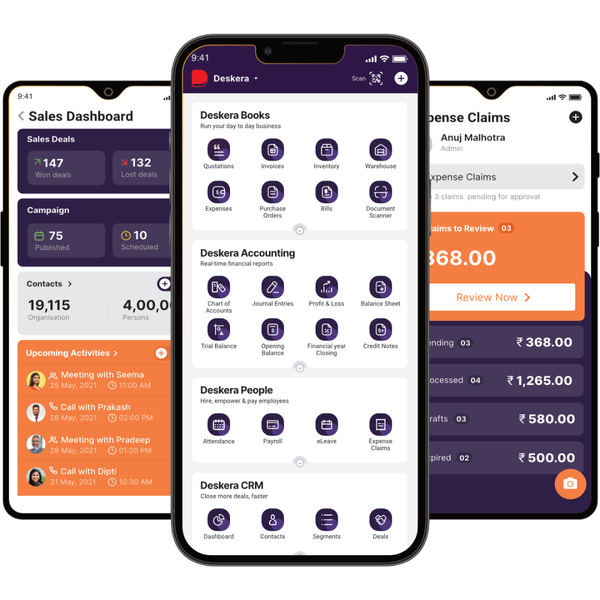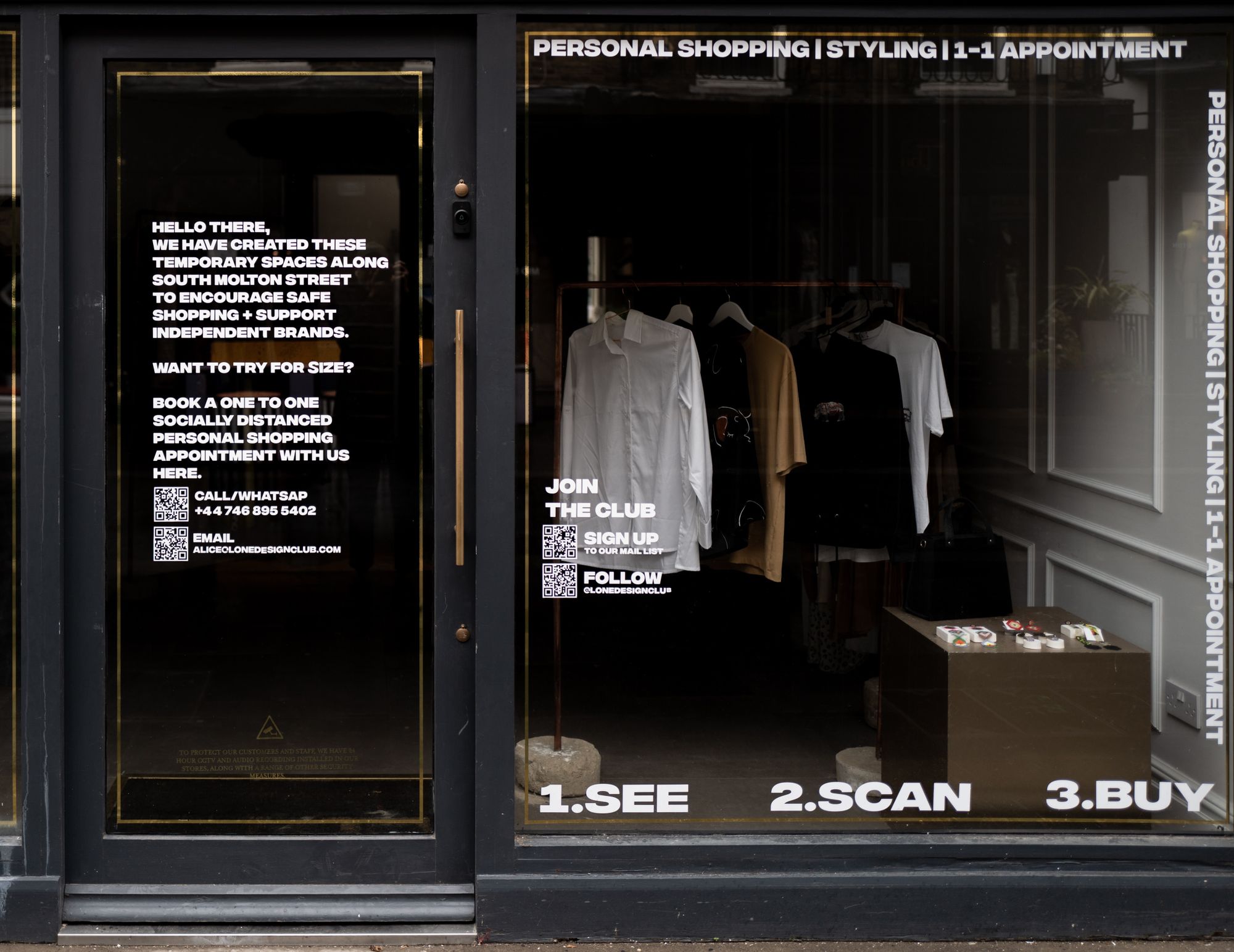In this digital era, it is natural that as a business owner you are likely to have multiple stores both online and offline. However is it easy to navigate products and manage your business? Certainly not. With the help of omnichannel order management your life can be made still easy. Want to learn what omnichannel order management is? Continue reading our article!

This article covers the following:
- What is Omnichannel Order Management?
- What are the benefits of an omnichannel order management system?
- What are the challenges of omnichannel order management?
- What are the strategies for implementing an omnichannel order management system?
- What are the best practices for optimizing an omnichannel order management system?
- What are some of the trends in omnichannel order management?
- What are some of the popular case studies of successful omnichannel order management systems?
- How can Deskera assist you?
What is Omnichannel Order Management & How Does it Work?
Omnichannel order management is an essential part of the modern business world. It’s a system that enables businesses to manage their orders across multiple channels, including web, mobile, retail, and more.
This system helps businesses to ensure that their customers have the best possible experience, no matter where they’re shopping. At its core, omnichannel order management is a combination of traditional order management with an integrated platform that allows businesses to manage their orders in an efficient and effective way.
By having a centralized order management system, businesses can ensure that their customers have a consistent experience, no matter which channel they’re using to shop. This system also allows businesses to streamline their operations and reduce costs.
The first step to setting up an omnichannel order management system is to identify the various channels that you’ll be using. This could include web, mobile, retail, and more.
Once you’ve identified the channels, you’ll need to decide how you’ll use each one. You’ll also need to set up a platform for tracking orders across these channels. This could be done through a third-party system, or you could create your own.
The next step is to create an inventory system that can track orders across all your channels. This system should track orders, inventory levels, and order status. It should also have the ability to quickly and easily update inventory levels and order status.
This will ensure that customers are always up-to-date on their orders and that they have a consistent experience. Once the inventory system is in place, you’ll need to set up a customer relationship management (CRM) platform.
This platform will be used to track customer information, such as contact information, order history, and more. This will help you to better understand your customers and better serve them.
Finally, you’ll need to set up an analytics system. This system will help you to analyze customer data, such as order history, order frequency, and more. By understanding customer data, you’ll be able to make better decisions about how to serve your customers.
These are the basic steps for setting up an omnichannel order management system. Once you have the system in place, you’ll be able to provide your customers with a consistent and efficient experience, no matter which channel they’re using to shop.
This will help you to increase customer satisfaction and loyalty, as well as reduce costs. Omnichannel order management is a powerful tool for businesses to use. It can help them to streamline their operations and reduce costs while also ensuring that their customers have a consistent and positive shopping experience.
By taking the time to set up a comprehensive order management system, you’ll be able to ensure that your customers are always happy and that your business is running smoothly.
What are the Benefits of Omnichannel Order Management?
Improved Customer Experience
With an omnichannel order management system, customers can have a seamless and consistent experience when shopping. Customers can easily switch between physical stores, websites, and mobile applications and be assured that their orders will be tracked, managed, and fulfilled effectively.
Increased Efficiency
By integrating all order management processes into one platform, businesses can significantly reduce manual labor and time spent managing orders.
Greater Visibility
An omnichannel order management system provides businesses with a comprehensive view of all orders, including order history, customer data, and inventory levels, which can help them make better decisions and improve their operations.
Increased Sales
With an omnichannel order management system, businesses can offer customers a better shopping experience and make it easier for them to purchase products. This can lead to increased sales and higher customer satisfaction.
Reduced Costs
With an omnichannel order management system, businesses can streamline their processes and reduce costs associated with manual order management. This can lead to increased profitability.
What are the Challenges in Omnichannel Order Management?
Omnichannel order management is an increasingly important part of the modern retail landscape. With consumers expecting quick and seamless service, retailers are looking for ways to optimize and streamline their processes to deliver a unified customer experience across all channels.
However, the implementation of an omnichannel order management system is not without its challenges. The most significant challenge of developing an omnichannel order management system is the complexity of the system.
Omnichannel order management requires retailers to integrate and connect multiple systems, including the point of sale, inventory, customer relationship management, and warehouse systems. This often necessitates the development of custom software applications to manage the different parts of the system.
Additionally, the integration of multiple systems and technologies can be difficult, as different systems may use different data formats or communication protocols, or may need customization for specific requirements.
Another challenge of an omnichannel order management system is the cost associated with its implementation and maintenance. Retailers need to invest in the software and hardware necessary for the system, as well as in the person who will maintain it.
Additionally, the system's security must be managed, as data, such as customer information and payment details, must be protected. This requires ongoing investments in security measures, such as data encryption, firewalls, and audit logs.
Ensuring accuracy and up-to-date information is another challenge of omnichannel order management. Since the system is integrated with multiple systems and technologies, any changes to one system must be reflected in all other systems. This can be difficult to maintain, as it requires constant monitoring of the different systems and technologies.
Additionally, any discrepancies between the systems can lead to confusion and errors, resulting in unhappy customers and costly returns. Finally, omnichannel order management systems need to be flexible and scalable, as the retail landscape is constantly changing.
Retailers need to be able to easily adjust their systems to accommodate changes in customer preferences, technology, and regulations. This requires a significant amount of time and resources for testing and updating the system. Overall, the implementation of an omnichannel order management system can be a challenging process.
However, by taking the time to understand the complexities of the system and implementing the necessary measures to ensure its accuracy and scalability, retailers can be well-positioned to reap the rewards of a successful omnichannel order management system.
What are the Strategies for Implementing Omnichannel Order Management?
Omnichannel order management is a system that allows businesses to manage customer orders from multiple channels such as web, mobile, and in-store. With an omnichannel approach, businesses are able to provide customers with a seamless and consistent shopping experience across all channels.
Implementing an omnichannel order management system can be a daunting task, but there are strategies that can help businesses make the transition. The first step in implementing an omnichannel order management system is to create a unified customer database.
A unified customer database contains customer data from all channels, allowing businesses to track customer purchases and preferences across the entire customer journey. This data can be used to personalize customer experiences and provide targeted promotions.
The next step is to create an integrated inventory system. An integrated inventory system allows businesses to track inventory levels across all channels. By tracking inventory levels, businesses can ensure that customers have access to products when they need them, and can better manage stock levels to prevent out-of-stocks.
Businesses also need to invest in an order management system that is integrated with the customer database and inventory system. An order management system allows businesses to manage orders from all channels in one place.
This includes tracking orders, processing payments, and managing returns. Businesses should also consider investing in a customer service platform. A customer service platform allows businesses to provide customers with support across all channels.
This includes providing customers with access to FAQs, live chat, and self-service options. Finally, businesses should consider investing in a marketing automation platform.
A marketing automation platform allows businesses to automate marketing tasks such as sending out promotional emails, creating ads, and more. This can help businesses save time and money, as well as ensure a consistent customer experience across all channels. Implementing an omnichannel order management system can be a complex process, but following these strategies can help businesses make the transition.
By investing in a unified customer database, integrated inventory system, order management system, customer service platform, and marketing automation platform, businesses can ensure that customers have a seamless and consistent shopping experience across all channels. This can help businesses increase customer loyalty, improve customer satisfaction, and boost sales.
What are Some of the Best Practices for Optimizing the Omnichannel Order Management System?
Utilize a single order management system (OMS) for all channels
By using a single OMS for all channels; businesses can ensure that all orders are processed in the same way and that all data is stored in a single repository. This will make it much easier to track and manage orders across the different channels.
Leverage real-time data
Real-time data can be used to make sure that customers receive the most accurate and up-to-date information regarding their orders. This includes order status, shipping information, and inventory availability.
Automate order processing
Automating order processing can help to reduce errors and speed up the time it takes to process orders. This is especially useful for large orders with multiple items.
Invest in customer service tools: Investing in the right customer service tools can help ensure that orders are fulfilled quickly and accurately. This includes customer service software and customer relationship management (CRM) systems.
Monitor customer feedback
Monitoring customer feedback can help to identify areas that need improvement in order to optimize the order management system.
Implement an order tracking system: An order tracking system can help to provide customers with real-time information on their orders and help to ensure that orders are fulfilled quickly and accurately.
What are Some of the Trends in Omnichannel Order Management?
Omnichannel order management is becoming increasingly important in the eCommerce world as businesses strive to provide customers with a seamless shopping experience.
As customers become more connected and technology advances, businesses must be able to offer a unified shopping experience across all channels. Here are some of the key trends in omnichannel order management that are driving this transformation.
Automation
Automation is one of the most important trends in omnichannel order management. Automated order management systems can help businesses streamline processes, reduce costs, and increase efficiency. Automation also helps to ensure that orders are accurate and fulfilled in a timely manner.
Inventory Visibility
Inventory visibility is a must for businesses that want to provide a seamless shopping experience. With inventory visibility, businesses can track orders across multiple channels and easily adjust inventory levels based on demand. This helps businesses to keep customers satisfied and avoid lost sales due to stockouts.
Personalization
Personalization is becoming increasingly important in order management. Consumers expect a personalized shopping experience, and businesses must be able to provide this in order to remain competitive. Order management systems can be used to personalize customer experiences by tracking customer data such as purchase history and preferences.
Integration
Integration is essential for businesses that want to provide a unified shopping experience across multiple channels. Order management systems should be integrated with other systems, such as inventory management and customer relationship management, to ensure that orders are accurate and customers are kept informed.
Data analysis
Data analysis is important for businesses that want to stay ahead of the competition. Order management systems can be used to analyze customer data to gain insights into customer behavior and preferences. This can help businesses better understand their customers and make informed decisions that will improve their customer experience.
Real-time updates
Real-time updates allow customers to track their orders in real-time and stay informed about the status of their orders. This helps to ensure that customers are kept informed and that orders are fulfilled in a timely manner.
Payment processing
Payment processing is a key component of order management. Order management systems must be able to process payments quickly and securely in order to keep customers happy and ensure that orders are fulfilled.
Mobile-friendly
Mobile-friendly order management systems are essential for businesses that want to provide customers with a seamless shopping experience across all devices. Mobile-friendly order management systems must be easy to use and optimized for mobile devices.
Security
Security is an important factor when it comes to ordering management. Order management systems must be secure and compliant with data protection laws to protect customer data and ensure that orders are processed securely.
Scalability
Scalability is important for businesses that want to expand their operations. Order management systems must be able to scale with the business and accommodate the changing needs of its customers.
The omnichannel order management space is constantly evolving, and these trends are making it easier for businesses to provide customers with a seamless shopping experience.
In order to remain competitive, businesses must stay ahead of the curve and ensure that their order management systems are up-to-date and able to accommodate the changing needs of their customers.
What are Some of the Popular Case Studies of Successful Omnichannel Order Management Systems?
Amazon
Amazon is one of the most popular and successful omnichannel order management systems in the world. It has revolutionized the way consumers shop by allowing customers to order products online or in-store and have them delivered to their homes.
With an integrated platform that connects its retail stores, warehouses, and delivery services, Amazon has created an efficient, seamless customer experience. Amazon’s order management system is an example of how retailers can leverage their physical and online stores to maximize sales.
Walmart
Walmart is another retail giant that has implemented an omnichannel order management system. Walmart’s system allows customers to shop online, in-store, or via their mobile app and have their orders delivered to their homes or local stores. It also offers a “Pickup Today” option, where customers can place their order online and pick it up at a Walmart store the same day. This system allows customers to quickly and easily shop for the items they need without having to wait for delivery.
Target
Target is another popular retailer that has implemented an omnichannel order management system. Target’s system is similar to Walmart’s in that customers can shop online, in-store, or via their mobile app.
However, Target also offers a “Ship to Store” option, which allows customers to have their orders shipped directly to their local Target store for free. This system allows customers to pick up their orders quickly and conveniently without having to wait for delivery.
Best Buy
Best Buy is yet another popular retailer that has implemented an omnichannel order management system. Like Target and Walmart, customers can shop online, in-store, or via their mobile app.
Best Buy also offers a “Buy Online Pickup In Store” option, where customers can purchase items online and pick them up at their local store the same day. This system allows customers to get the items they need quickly and conveniently without having to wait for delivery.
Kohl’s
Kohl’s is also a popular retailer that has implemented an omnichannel order management system. Kohl’s system allows customers to shop online, in-store, or via their mobile app and have their orders delivered to their homes or local stores.
Additionally, Kohl’s offers a “Buy Online Pickup In Store” option, where customers can purchase items online and pick them up at their local store the same day. This system allows customers to get the items they need quickly and conveniently without having to wait for delivery.
Home Depot
Home Depot has also implemented an omnichannel order management system. Home Depot’s system allows customers to shop online, in-store, or via their mobile app and have their orders delivered to their homes or local stores.
Additionally, Home Depot offers a “Buy Online Pickup In Store” option, where customers can purchase items online and pick them up at their local store the same day. This system allows customers to get the items they need quickly and conveniently without having to wait for delivery.
Macy’s
Macy’s is another popular retailer that has implemented an omnichannel order management system. Macy’s system allows customers to shop online, in-store, or via their mobile app and have their orders delivered to their homes or local stores.
Additionally, Macy’s offers a “Buy Online Pickup In Store” option, where customers can purchase items online and pick them up at their local store the same day. This system allows customers to get the items they need quickly and conveniently without having to wait for delivery.
Lowe’s
Lowe’s is another popular retailer that has implemented an omnichannel order management system. Lowe’s system allows customers to shop online, in-store, or via their mobile app and have their orders delivered to their homes or local stores.
Additionally, Lowe’s offers a “Buy Online Pickup In Store” option, where customers can purchase items online and pick them up at their local store the same day. This system allows customers to get the items they need quickly and conveniently without having to wait for delivery.
Nordstrom
Nordstrom is yet another popular retailer that has implemented an omnichannel order management system. Nordstrom’s system allows customers to shop online, in-store, or via their mobile app and have their orders delivered to their homes or local stores.
Additionally, Nordstrom offers a “Buy Online Pickup In Store” option, where customers can purchase items online and pick them up at their local store the same day. This system allows customers to get the items they need quickly and conveniently without having to wait for delivery.
Sephora
Sephora is another popular retailer that has implemented an omnichannel order management system. Sephora’s system allows customers to shop online, in-store, or via their mobile app and have their orders delivered to their homes or local stores.
Additionally, Sephora offers a “Buy Online Pickup In Store” option, where customers can purchase items online and pick them up at their local store the same day. This system allows customers to get the items they need quickly and conveniently without having to wait for delivery.
How Can Deskera Assist You?
Remember discussing best-in-class inventory software? There is no way you can find anything as well-equipped as the Deskera inventory software. Deskera inventory software allows you to closely monitor the manufacturing process.

Related Articles:












